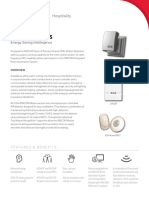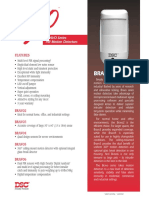26 - 09 - 23 Lighting Controls
26 - 09 - 23 Lighting Controls
Uploaded by
xdbxbg4fptCopyright:
Available Formats
26 - 09 - 23 Lighting Controls
26 - 09 - 23 Lighting Controls
Uploaded by
xdbxbg4fptOriginal Description:
Original Title
Copyright
Available Formats
Share this document
Did you find this document useful?
Is this content inappropriate?
Copyright:
Available Formats
26 - 09 - 23 Lighting Controls
26 - 09 - 23 Lighting Controls
Uploaded by
xdbxbg4fptCopyright:
Available Formats
SECTION 26 09 23
LIGHTING CONTROLS
PART 1 - GENERAL
1.1 DESCRIPTION
This section specifies the furnishing, installation and connection of the lighting controls.
1.2 RELATED WORK
A. Section 23 09 23, DIRECT-DIGITAL CONTROL SYSTEM FOR HVAC: Interface of
lighting controls with HVAC control systems.
B. Section 26 05 11, REQUIREMENTS FOR ELECTRICAL INSTALLATIONS: General
requirements that are common to more than one section of Division 26.
C. Section 26 05 19, LOW-VOLTAGE ELECTRICAL POWER CONDUCTORS AND
CABLES (600 VOLTS AND BELOW): Cables and wiring.
D. Section 26 05 26, GROUNDING AND BONDING FOR ELECTRICAL SYSTEMS:
Requirements for personnel safety and to provide a low impedance path to ground for
possible ground fault currents.
E. Section 26 24 16, PANELBOARDS: Panelboard enclosure and interior bussing used for
lighting control panels.
F. Section 26 27 26, WIRING DEVICES: Wiring devices used for control of the lighting
systems.
G. Section 26 51 00, INTERIOR LIGHTING: Luminaire ballast and drivers used in control of
lighting systems.
1.3 QUALITY ASSURANCE
A. Quality Assurance shall be in accordance with Paragraph, QUALIFICATIONS
(PRODUCTS AND SERVICES) in Section 26 05 11, REQUIREMENTS FOR
ELECTRICAL INSTALLATIONS.
1.4 SUBMITTALS
A. Submit in accordance with Paragraph, SUBMITTALS in Section 26 05 11,
REQUIREMENTS FOR ELECTRICAL INSTALLATIONS, and the following
requirements:
1. Shop Drawings:
a. Submit the following information for each type of lighting controls.
Avenida Escazú Edificio 202, Segundo piso. Oficina 205
Tel: +506 4001-6677 • info@ingenya.co.cr
www.ingenyaconsultores.com
b. Material and construction details.
c. Physical dimensions and description.
d. Wiring schematic and connection diagram.
e. Installation details.
2. Manuals:
a. Submit, simultaneously with the shop drawings, complete maintenance and
operating manuals, including technical data sheets, wiring diagrams, and
information for ordering replacement parts.
b. If changes have been made to the maintenance and operating manuals originally
submitted, submit updated maintenance and operating manuals two weeks prior
to the final inspection.
3. Certifications: Two weeks prior to final inspection, submit the following.
a. Certification by the Contractor that the lighting control systems have been
properly installed and tested.
1.5 APPLICABLE PUBLICATIONS
A. Publications listed below (including amendments, addenda, revisions, supplements, and
errata) form a part of this specification to the extent referenced. Publications are
referenced in the text by designation only.
B. National Electrical Manufacturer's Association (NEMA):
C136.10-10 ........................... American National Standard for Roadway and Area Lighting
Equipment—Locking-Type Photocontrol Devices and
Mating Receptacles—Physical and Electrical
Interchangeability and Testing
ICS-1-15 ................................ Standard for Industrial Control and Systems General
Requirements
ICS-2-05 ................................ Standard for Industrial Control and Systems: Controllers,
Contractors, and Overload Relays Rated Not More than
2000 Volts AC or 750 Volts DC: Part 8 - Disconnect
Devices for Use in Industrial Control Equipment
ICS-6-16 ................................ Standard for Industrial Controls and Systems Enclosures
C. National Fire Protection Association (NFPA):
Avenida Escazú Edificio 202, Segundo piso. Oficina 205
Tel: +506 4001-6677 • info@ingenya.co.cr
www.ingenyaconsultores.com
70-17 ..................................... National Electrical Code (NEC)
D. Underwriters Laboratories, Inc. (UL):
20-10 ..................................... Standard for General-Use Snap Switches
98-16 ..................................... Enclosed and Dead-Front Switches
773-16 ................................... Standard for Plug-In Locking Type Photocontrols for Use
with Area Lighting
773A-16................................. Nonindustrial Photoelectric Switches for Lighting Control
916-15 ................................... Standard for Energy Management Equipment Systems
917-06 ................................... Clock Operated Switches
924-16 ................................... Emergency Lighting and Power Equipment (for use when
controlling emergency circuits).
PART 2 - PRODUCTS
2.1 ELECTRONIC TIME SWITCHES
A. Electronic, solid-state programmable units with alphanumeric display; complying with
UL 916 and or 917.
1. Contact Configuration: SPST.
2. Contact Rating: 20-A ballast load, 120-277 volt.
3. Astronomical Clock: Capable of switching a load on at sunset and off at sunrise, and
automatically changing the settings each day in accordance with seasonal changes
of sunset and sunrise. Additionally, it shall be programmable to a fixed on/off weekly
schedule.
4. Power Backup: Battery or capacitor for schedules and time clock.
2.2 ELECTROMECHANICAL-DIAL TIME SWITCHES
A. Electromechanical-dial time switches; complying with UL 917.
1. Contact Configuration: SPST.
2. Contact Rating: 20-A ballast load, 120-277 volt.
3. Wound-spring reserve carryover mechanism to keep time during power failures.
2.3 OUTDOOR PHOTOELECTRIC SWITCHES
A. Solid state, with SPST dry contacts rated for 1800 VA tungsten or 1000 VA inductive,
complying with UL 773A.
Avenida Escazú Edificio 202, Segundo piso. Oficina 205
Tel: +506 4001-6677 • info@ingenya.co.cr
www.ingenyaconsultores.com
1. Light-Level Monitoring Range: 16.14 to 108 lx (1.5 to 10 fc), with adjustable turn-on
and turn-off levels.
2. Time Delay: 15-second minimum.
3. Surge Protection: Metal-oxide varistor.
4. Mounting: Twist lock, with base-and-stem mounting or stem-and-swivel mounting
accessories as required.
2.4 TIMER SWITCHES
A. Digital switches with backlit LCD display, 120/277 volt rated, fitting as a replacement for
standard wall switches.
1. Compatibility: Compatible with all ballasts.
2. Warning: Audible warning to sound during the last minute of “on” operation.
3. Time-out: Adjustable from 5 minutes to 12 hours.
4. Faceplate: Refer to wall plate material and color requirements for toggle switches,
as specified in Section 26 27 26, WIRING DEVICES.
2.5 CEILING-MOUNTED PHOTOELECTRIC SWITCHES
A. Solid-state, light-level sensor unit, with separate relay unit.
1. Sensor Output: Contacts rated to operate the associated relay. Sensor shall be
powered from the relay unit.
2. Relay Unit: Dry contacts rated for 20A ballast load at 120 volt and 277 volt, for 13A
tungsten at 120 volt, and for 1 hp at 120 volt.
3. Monitoring Range: 1080 to 10 800 lx (100 to 1000 fc), with an adjustment for turn-on
and turn-off levels.
4. Time Delay: Adjustable from 5 to 300 seconds, with deadband adjustment.
5. Indicator: Two LEDs to indicate the beginning of on-off cycles.
2.6 SKYLIGHT PHOTOELECTRIC SENSORS
A. Solid-state, light-level sensor; housed in a threaded, plastic fitting for mounting under
skylight; with separate relay unit.
1. Sensor Output: Contacts rated to operate the associated relay, complying with
UL 773A. Sensor shall be powered from the relay unit.
2. Relay Unit: Dry contacts rated for 20A ballast load at 120 volt and 277 volt, for 13A
tungsten at 120 volt, and for 1 hp at 120 volt.
Avenida Escazú Edificio 202, Segundo piso. Oficina 205
Tel: +506 4001-6677 • info@ingenya.co.cr
www.ingenyaconsultores.com
3. Monitoring Range: 10,800 to 108,000 lx (1000 to 10,000 fc), with an adjustment for
turn-on and turn-off levels.
4. Time Delay: Adjustable from 5 to 300 seconds, with deadband adjustment.
5. Indicator: Two LEDs to indicate the beginning of on-off cycles.
2.7 INDOOR OCCUPANCY SENSORS
A. Wall- or ceiling-mounting, solid-state units with a power supply and relay unit, suitable
for the environmental conditions in which installed.
1. Operation: Unless otherwise indicated, turn lights on when covered area is occupied
and off when unoccupied; with a 1 to 15 minute adjustable time delay for turning
lights off.
2. Sensor Output: Contacts rated to operate the connected relay. Sensor shall be
powered from the relay unit.
3. Relay Unit: Dry contacts rated for 20A ballast load at 120 volt and 277 volt, for 13A
tungsten at 120 volt, and for 1 hp at 120 volt.
4. Mounting:
a. Sensor: Suitable for mounting in any position on a standard outlet box.
b. Time-Delay and Sensitivity Adjustments: Recessed and concealed behind
hinged door.
5. Indicator: LED, to show when motion is being detected during testing and normal
operation of the sensor.
6. Bypass Switch: Override the on function in case of sensor failure.
7. Manual/automatic selector switch.
8. Automatic Light-Level Sensor: Adjustable from 21.5 to 2152 lx (2 to 200 fc); keep
lighting off when selected lighting level is present.
9. Faceplate for Wall-Switch Replacement Type: Refer to wall plate material and color
requirements for toggle switches, as specified in Section 26 27 26, WIRING
DEVICES.
B. Dual-technology Type: Ceiling mounting; combination PIR and ultrasonic detection
methods, field-selectable.
1. Sensitivity Adjustment: Separate for each sensing technology.
Avenida Escazú Edificio 202, Segundo piso. Oficina 205
Tel: +506 4001-6677 • info@ingenya.co.cr
www.ingenyaconsultores.com
2. Detector Sensitivity: Detect occurrences of 150 mm (6-inch) minimum movement of
any portion of a human body that presents a target of not less than 232 sq. cm (36
sq. in), and detect a person of average size and weight moving not less than 305 mm
(12 inches) in either a horizontal or a vertical manner at an approximate speed of
305 mm/s (12 inches/s).
C. Detection Coverage: Shall be sufficient to provide coverage as required by sensor
locations shown on drawing.
2.8 INDOOR VACANCY SENSOR SWITCH
A. Wall mounting, solid-state units with integral sensor and switch.
1. Operation: Manually turn lights on with switch and sensor detects vacancy to turn
lights off.
2. Switch Rating: 120/277 volt, 1200 watts at 277 volt, 800 watts at 120 volt unit.
3. Mounting:
a. Sensor: Suitable for mounting in a standard switch box.
b. Time-Delay and Sensitivity Adjustments: Integral with switch and accessible for
reprogramming without removing switch.
4. Indicator: LED, to show when motion is being detected during testing and normal
operation of the sensor.
5. Switch: Manual operation to turn lights on and override lights off.
6. Faceplate: Refer to wall plate material and color requirements for toggle switches, as
specified in Section 26 27 26, WIRING DEVICES.
2.9 OUTDOOR MOTION SENSOR (PIR)
A. Suitable for operation in ambient temperatures ranging from minus 40 to plus 130
degrees F (minus 40 to plus 54 degrees C).
1. Operation: Turn lights on when sensing infrared energy changes between
background and moving body in area of coverage; with a 1 to 15 minute adjustable
time delay for turning lights off.
2. Mounting:
a. Sensor: Suitable for mounting in any position on a standard outdoor junction
box.
b. Relay: Internally mounted in a standard weatherproof electrical enclosure.
Avenida Escazú Edificio 202, Segundo piso. Oficina 205
Tel: +506 4001-6677 • info@ingenya.co.cr
www.ingenyaconsultores.com
c. Time-Delay and Sensitivity Adjustments: Recessed and concealed behind
hinged door.
3. Bypass Switch: Override the on function in case of sensor failure.
4. Automatic Light-Level Sensor: Adjustable from 11 to 215 lx (1 to 20 fc); keep lighting
off during daylight hours.
B. Detector Sensitivity: Detect occurrences of 150 mm (6-inch) minimum movement of any
portion of a human body that presents a target of not less than 232 sq. cm (36 sq. in).
C. Detection Coverage: Shall be sufficient to provide coverage as required by sensor
locations shown on drawing.
D. Individually Mounted Sensor: Contacts rated to operate the connected relay, complying
with UL 773A. Sensor shall be powered from the relay unit.
1. Relay Unit: Dry contacts rated for 20A ballast load at 120 volt and 277 volt, for 13A
tungsten at 120 volt, and for 1 hp at 120 volt.
2. Indicator: LED, to show when motion is being detected during testing and normal
operation of the sensor.
2.10 LIGHTING CONTROL SYSTEML – CIRCUIT BREAKER PANEL TYPE
A. Controller: Panelboard mounted in compliance with UL 916, programmable, solid-state,
astronomic 365-day timing and control unit with non-volatile memory. Controller shall be
integral to panelboard as specified in Section 26 24 16, PANELBOARDS. Controller
shall be capable of receiving inputs from sensors and other sources, and capable of
timed overrides and/or blink-warning on a per-circuit basis. Controller communication
protocol shall be compatible with the building automation system specified in Section 23
09 23, DIRECT-DIGITAL CONTROL SYSTEM FOR HVAC. Panelboard shall use low-
voltage-controlled, electrically operated molded-case branch circuit breakers or molded-
case branch circuit breakers with switching accessories. Circuit breakers and a limited
number of digital or analog, low-voltage control-circuit outputs shall be individually
controlled by control module. Panelboard shall also comply with Section 24 26 16,
PANELBOARDS.
B. Electrically Operated, Molded-Case Circuit-Breaker Panelboard: Per Section 26 24 16,
PANELBOARDS.
Avenida Escazú Edificio 202, Segundo piso. Oficina 205
Tel: +506 4001-6677 • info@ingenya.co.cr
www.ingenyaconsultores.com
C. Electrically Operated, Molded-Case Circuit Breakers: Per Section 26 24 16,
PANELBOARDS.
D. Switching Endurance Ratings: Rated at least 20,000 open and close operations under
rated load at 0.8 power factor.
2.11 CONTROL SYSTEM
Lighting control zones shall consist of one or more intelligent lighting control components (digital
load controllers), be capable of stand-alone operation, and be capable of being connected to a
higher-level network backbone.
Network Characteristics
• In-Room Network:
o The In-Room network shall be a free topology lighting control network using
physical wiring connections and communication protocol designed to control a
room/space/small area of a building.
o Digital room devices connect to the In-Room network, which provides both
communications and power to room devices.
• Global Network (In-Room to In-Room Network):
o The Global network shall be a linear topology network to connect In-Room
networks and relay panels (if applicable) for centralized control.
o Each In-Room Network to be connected to the Global Network shall include a
single network bridge, and the network bridge is the only room-based device that
is connected to the Global Network.
o The Global Network shall utilize communications cabling as specified by the
manufacturer. The maximum cable run for each segment (distance between In-
Room Networks) shall meet manufacturer limitations.
Individual lighting zones must continue to provide a user defined default level of lighting control
in the event of a system communication failure with the Global Network or the management
software becoming unavailable.
Avenida Escazú Edificio 202, Segundo piso. Oficina 205
Tel: +506 4001-6677 • info@ingenya.co.cr
www.ingenyaconsultores.com
All switching and dimming for a specific lighting zone shall take place within the devices located
in the zone itself (i.e., not in remotely located devices such as panels) to facilitate system
robustness and minimize wiring requirements. Specific applications that require centralized or
remote switching shall be capable of being accommodated.
System shall be capable of using a web-based software management program that enables
remote system control, status monitoring, and creation of lighting control schedules and profiles.
[Connect all noted In-Room Networks to the Global Network for building-wide monitoring and
management via PC-based Management Software and/or the building automation system
(BAS). Provide optional Management Software for remote system control, status monitoring,
and creation of lighting control schedules and profiles.]
2.12 DIGITAL LOAD CONTROLLERS (ROOM CONTROLLERS)
General
Digital load controllers shall be simple to install and shall not have dip switches or
potentiometers, or require special configuration.
The controllers shall include the following features:
• Standard junction box mounting.
• Low voltage connection using standard RJ-45 connectors and CAT5e cable. Other wiring
topologies are acceptable if controls accomplish all requirements specified in these
documents.
• Each connected load shall be capable of any of the following behaviors: Manual ON,
Automatic ON, Automatic ON to 50 percent, or Automatic ON to Preset level or last level
set.
• UL 2043 plenum rated.
• Manual override and LED indication for each load.
• Power supply to power the digital load controller itself and the peripheral sensors and
Avenida Escazú Edificio 202, Segundo piso. Oficina 205
Tel: +506 4001-6677 • info@ingenya.co.cr
www.ingenyaconsultores.com
controls connected to the In-Room Network.
• Dual voltage (120/277 VAC, 60 Hz), rated for 20A total load, derating to 16A required for
some dimmed loads (forward phase dimming).
• Zero cross circuitry for each load.
• All digital parameter data programmed into an individual room controller or plug load
controller shall be retained in non-volatile FLASH memory within the controller itself.
Memory shall have an expected life of no less than 10 years.
2.13 CONTROL ON/OFF LOAD CONTROLLERS
Controllers shall include the following:
• Multiple relay configurations per unit.
2.14 ON/OFF/DIMMING LOAD CONTROLLERS
Controllers shall include the following:
• Multiple relay configurations per unit.
• Each dimming output channel shall have an independently configurable minimum and
maximum calibration trim level to set the dimming range to match the true dynamic range
of the connected LED driver.
• One dimming output per relay.
o 0-10V Dimming: Where indicated, one 0-10 volt analog output per relay for
control of compatible LED drivers. The 0-10 volt output shall automatically close
upon loss of power to the Controller to assure full light output from the controlled
lighting.
o Line Voltage, Forward Phase Dimming: Where indicated, one forward phase
control line voltage dimming output per relay for control of compatible LED
drivers, forward phase compatible ELV, and incandescent loads.
• Each load shall have an independently configurable preset ON level for Normal Hours
and After-Hours events to allow different dimmed levels to be established at the start of
both Normal Hours and After-Hours events.
Avenida Escazú Edificio 202, Segundo piso. Oficina 205
Tel: +506 4001-6677 • info@ingenya.co.cr
www.ingenyaconsultores.com
2.15 DIGITAL MOTION SENSORS
General
Sensors shall be available in wall, ceiling, corner-mounted, or wall-switch configurations.
Sensors shall use either passive infrared (PIR) sensing, or if dual technology, passive infrared
and passive acoustic or passive infrared and ultrasonic sensing for detecting room occupancy.
Sensors shall be able to function together with other sensors in order to provide expanded
coverage areas.
Features
Sensors shall be provided with the following features:
• Sensitivity Adjustment, Time Delay, Detection Technology, and Walk-Through Mode.
• Dual-Technology Sensors shall have independent configurable trigger modes to choose
proper technology according to space use to eliminate false-triggers.
• Each sensor may be programmed to control specific loads within an In-Room network.
• Each sensor shall allow remote programming through a handheld commissioning tool via
a two-way infrared (IR) transceiver or by configuration through a local network device.
2.16 DIGITAL WALL SWITCH MOTION SENSORS
Digital wall switch motion sensors shall be provided with the following features:
• Shall not allow current to pass to the load when sensor is in the unoccupied (Off)
condition.
• One- or two-button switches for one or two switch-legs.
• Optional daylight sensor feature for daylighting override.
2.17 DIGITAL DAYLIGHT SENSORS
Daylight sensors shall be provided with the following features:
• Digital daylighting sensors shall work with room controllers to provide automatic
switching, bi-level, tri-level, or dimming daylight harvesting capabilities for any load type
connected to a room controller.
Avenida Escazú Edificio 202, Segundo piso. Oficina 205
Tel: +506 4001-6677 • info@ingenya.co.cr
www.ingenyaconsultores.com
• Daylighting sensors shall be interchangeable without the need for rewiring.
• Sensor light level range shall be from 1-250 foot-candles (fc).
• For switching daylight harvesting, the daylight sensor shall provide a field-selectable
deadband (separation) between the “ON” setpoint and the “OFF” setpoint that will prevent
the lights from cycling excessively after they turn OFF.
• For dimming daylight harvesting, the daylight sensor shall provide the option, when the
daylight contribution is sufficient, of turning lights OFF or dimming lights to a field-
selectable minimum level.
• Delay shall be incorporated into the photocell to prevent rapid response to passing
clouds.
• Daylight sensors shall have an independently configurable fade rate for both increasing
and decreasing light level in units of percent-per-second.
• Daylight Sensors shall provide adjustable cut-off time (0-120 minutes). Cut-off time is
defined by the number of selected minutes the load is at the minimum output before the
load turns off.
• Optional wall switch override shall allow occupants to reduce lighting level to increase
energy savings or, if permitted by system administrator, raise lighting levels for a
selectable period of time or cycle of occupancy.
• Each sensor shall allow remote programming through a handheld commissioning tool via
a two-way infrared (IR) transceiver or by configuration through a local network device.
2.18 DIGITAL MANUAL CONTROLS
Wall Switches
Low voltage dimming and momentary pushbutton switches in 1, 2, 3, 4, 5, and 8 Button
configurations.
Wall switches shall include the following features:
• Buttons may be programmed as Load or Scene Buttons.
• Buttons may be programmed as ON/OFF, ON only, or OFF only.
• Switch buttons may be bound to any load on a room controller and are not load type
dependent.
Avenida Escazú Edificio 202, Segundo piso. Oficina 205
Tel: +506 4001-6677 • info@ingenya.co.cr
www.ingenyaconsultores.com
Dimmer Switches
• Raise/lower dimming adjustment controls.
• Dimmer switches shall include multiple LEDS to indicate load levels.
• Dimmer switches shall be able to be ganged with multi-button switches under the same
wall plate.
• Three-way and 4-way switch locations are supported for ON/OFF or Dimming control.
2.19 DIGITAL SCENE SWITCHES
• Scene switches allow for Preset Scene recall and dimming override control.
2.20 TOUCH PANEL CONTROLS
Touch Panel Controls are allowed, but not required. Touch Panel Controls are used for
adjusting lighting and to set up and control preset lighting scenes in the associated room/space.
Touch panel controls shall be provided with the following features:
• Full-color multi-touch capacitive touchscreen for controlling lighting and system
components
• Control up to 16 dynamic lighting zones/scenes per touch screen or acting as up to 16
ON/OFF/DIM control switches
• Lighting zones/scenes can be comprised of lighting intensity, color, color temperature,
and luminaire position
• Modify color and color temperature using a digital color palette and UV rating scale
• Proximity screen sensor for auto “wake-up”
• Auto dimming and user adjustable backlight
• Device shall enable configuration of all switches, dimmers, and lighting preset scenes via
password protected setup screens. User programmable screen lock limiting access to all
feature controls and programming
• Full alpha-numeric scene and zone naming
• Configurable interface to reflect project requirements
• Lighting zones/scenes support control of forward/reverse phase dimming, 0-10V, RGB,
Avenida Escazú Edificio 202, Segundo piso. Oficina 205
Tel: +506 4001-6677 • info@ingenya.co.cr
www.ingenyaconsultores.com
tunable white, and moving fixtures
• Integral astronomical time clock enables lighting scenes
• Partition status control and visualization
• Direct DMX control
• Digital motion senor control
• Digital daylight harvesting response
• Shall have the ability to control connected load through time schedules.
• RS-232/contact closure capable for 3rd party integration
• Local wireless Bluetooth connectivity with mobile app
• Device shall have a micro-USB style connector for local computer connectivity.
• Remote-mounted power supply
2.21 DIGITAL LED LUMINAIRES
Digital LED Luminaires are luminaires with embedded controls (a.k.a. “enabled” luminaires).
Luminaires with embedded controls are not allowed.
2.22 DIGITAL AUXILIARY INPUT/OUTPUT (I/O) INTERFACE MODULES
General
• Operate on Class 2 power supplied by In-Room network.
• Status LEDs indicate if input is energized.
• UL 2043 plenum rated where required.
Switched Contact Closure Interface
• Utilized for automatic control via input from other sources such as switches, relay-based
system, BAS, etc.
• Includes 24VDC output and input terminals for momentary or maintained third party
contact closure inputs.
• Utilize input module for an Auto ON and Sweep OFF function input from other sources for
the controlled area. During normal hours of operation, all local low-voltage devices are
fully operational. During after hours, a timer shall be applied to all low-voltage switches or
Avenida Escazú Edificio 202, Segundo piso. Oficina 205
Tel: +506 4001-6677 • info@ingenya.co.cr
www.ingenyaconsultores.com
dimmers so that the room will automatically sweep off every two hours following switch
activation. Provide a blink warning to alert occupants of impending OFF.
• Specific I/O devices shall have a dimming control output that can control 0-10 VDC
dimmable ballasts or LED drivers by sinking up to 20 mA of current.
• Specific I/O devices shall have an input that reads a 0-10 VDC signal from an external
device.
• Specific I/O devices shall have a switch input that can interface with either a maintained
or momentary switch and run a switch event (e.g., toggle the lighting load) or run a
local/remote control profile.
• Specific I/O devices shall sense state of low-voltage outdoor photocells.
• Specific I/O devices shall sense momentary and maintained contact closures, and either
toggle a connected load after a momentary contact or ramp the load high/low during a
maintained contact (stopping when the contact releases).
Serial Data Interface
• Utilized for control from A/V system to send ON/OFF/Preset commands to In-Room
Network.
• Includes 24VDC output and 10 pin RS232 connection.
• Coordinate programming with the Distributed Digital Lighting Control System
manufacturer’s technician and the A/V system technician for successful interface
between both systems.
2.23 DIGITAL LIGHTING CONTROL PANELS (RELAY AND DIMMING PANELS)
General
It is the intent of this paragraph to provide a Digital Lighting Control Panel as part of an
integrated lighting control system. Contractor is responsible for confirming that the panels and
associated peripheral devices such as sensors and manual controls interoperate as a single
system.
Digital Lighting Control Panels shall be incorporated into the lighting control system Global
Network where used.
Avenida Escazú Edificio 202, Segundo piso. Oficina 205
Tel: +506 4001-6677 • info@ingenya.co.cr
www.ingenyaconsultores.com
Provide lighting control panels in the locations and capacities as indicated on the plans and
schedules. Each panel shall be of modular construction and consist of the following
components:
• The panel cover shall have a hinged and lockable door with restricted access to line
voltage section of the panel.
• The interior construction shall provide total isolation of line voltage (Class 1) wiring from
low voltage (Class 2) wiring within the assembled panel.
• Direct wired switch inputs associated with each relay shall support two-wire, momentary
or maintained contact switches.
• Digital inputs shall support digital switches, digital I/O modules capable of receiving 0-5V
or 0-10V analog photocell inputs, digital I/O modules capable of receiving momentary or
maintained contact closure inputs, digital photocell modules, and digital occupancy
sensors.
• Power supply shall be a multi-voltage transformer assembly with rated power to supply all
electronics, occupancy sensors, switches, pilot lights, and photocells associated with the
lighting control panel as necessary to meet the project requirements.
2.24 RELAYS
Relays shall provide the following ratings and features:
• Panel shall provide one 0-10VDC dimming output paired with each relay.
• Each relay shall contain an LED status light and an override pushbutton. True relay state
shall be indicated by the on-board LED and shall be available to external control devices
and systems via BACnet. Isolated low voltage contacts provide for true relay status
feedback and pilot light indication.
• Relays shall be individually replaceable in a modular plug-in design.
• Relays shall be single-phase normally-closed latching type relays capable of switching
120/277 VAC or two-phase relays capable of switching 208/240/480 VAC loads.
• Relays shall be rated to switch up to a 30A ballast load at 277 VAC.
• Tested to 300,000 mechanical on/off cycles.
• Relay operation shall be automatically sequenced to reduce impact on the electrical
Avenida Escazú Edificio 202, Segundo piso. Oficina 205
Tel: +506 4001-6677 • info@ingenya.co.cr
www.ingenyaconsultores.com
distribution system when large loads are controlled simultaneously.
PART 3 - EXECUTION
3.1 INSTALLATION
A. Installation shall be in accordance with the NEC, manufacturer's instructions, as shown
on the drawings, and as specified.
B. Aim outdoor photoelectric sensor according to manufacturer's recommendations. Set
adjustable window slide for 1 footcandle turn-on.
C. Aiming for wall-mounted and ceiling-mounted motion sensor switches shall be per
manufacturer’s recommendations.
D. Set occupancy sensor "on" duration to //5// //10// //15// minutes.
E. Locate photoelectric sensors as indicated and in accordance with the manufacturer's
recommendations. Adjust sensor for the available light level at the typical work plane for
that area.
F. Label time switches and contactors with a unique designation.
G. Program lighting control panels per schedule on drawings.
3.2 ACCEPTANCE CHECKS AND TESTS
A. Perform in accordance with the manufacturer's recommendations.
B. Upon completion of installation, conduct an operating test to show that equipment
operates in accordance with requirements of this section.
C. Test for full range of dimming ballast and dimming controls capability. Observe for
visually detectable flicker over full dimming range.
D. Test occupancy sensors for proper operation. Observe for light control over entire area
being covered.
Avenida Escazú Edificio 202, Segundo piso. Oficina 205
Tel: +506 4001-6677 • info@ingenya.co.cr
www.ingenyaconsultores.com
E. Upon completion of the installation, the system shall be commissioned by the
manufacturer’s factory-authorized technician who will verify all adjustments and sensor
placements.
3.3 FOLLOW-UP VERIFICATION
Upon completion of acceptance checks and tests, the Contractor shall show by
demonstration in service that the lighting control devices are in good operating condition
and properly performing the intended function in the presence of Resident Engineer.
3.4 INSTRUCTION
A. Furnish the services of a factory-trained technician for one 8-hour training period for
instructing personnel in the maintenance and operation of the lighting control system on
the dates requested by the Resident Engineer.
B. Contractor shall submit written instructions on training and maintenance as reviewed in
training session.
END OF SECTION
Avenida Escazú Edificio 202, Segundo piso. Oficina 205
Tel: +506 4001-6677 • info@ingenya.co.cr
www.ingenyaconsultores.com
You might also like
- Alarm System PR-JT-10GDT User ManualDocument20 pagesAlarm System PR-JT-10GDT User Manualexo69No ratings yet
- 26 09 23 Lighting Control DevicesDocument14 pages26 09 23 Lighting Control DevicesOZAYR YMNo ratings yet
- Lutron MyroomDocument41 pagesLutron Myrooming.albertopolendoNo ratings yet
- CONTROL AND RELAY PANEL - Rev 5Document55 pagesCONTROL AND RELAY PANEL - Rev 5varshiniamrutha672No ratings yet
- SECTION 16675 Isolated Power SystemsDocument7 pagesSECTION 16675 Isolated Power Systemsno nameNo ratings yet
- SECTION 16170 Disconnect Switches (Motor and Circuit)Document3 pagesSECTION 16170 Disconnect Switches (Motor and Circuit)no nameNo ratings yet
- Lighting Philosphy NTPCDocument8 pagesLighting Philosphy NTPCHarpreet SinghNo ratings yet
- Control and Relay Panel Feb 2021Document53 pagesControl and Relay Panel Feb 2021JITURANJAN100% (1)
- Specification 33KV GIS ZX0.2Document16 pagesSpecification 33KV GIS ZX0.2BADRI VENKATESHNo ratings yet
- Sec 16410 - Power Factor CorrectionDocument7 pagesSec 16410 - Power Factor CorrectionFadi FarseNo ratings yet
- SPC - 01 - Sec-263600 - Transfer SwitchesDocument6 pagesSPC - 01 - Sec-263600 - Transfer Switchesfouadelshabrawy71No ratings yet
- Power Flex 7000 Specification GuideDocument40 pagesPower Flex 7000 Specification Guideoadipphone7031No ratings yet
- 6305-El-Etp-7020-A00 DC DBDocument13 pages6305-El-Etp-7020-A00 DC DBvicesuza87No ratings yet
- Circuit Breaker SpecificationDocument60 pagesCircuit Breaker SpecificationYash YadavNo ratings yet
- SECTION 16340 Medium Voltage Switching and Protection Assemblies Rev 0Document38 pagesSECTION 16340 Medium Voltage Switching and Protection Assemblies Rev 0Filopimin ParaskevopoulosNo ratings yet
- Advc N SeriesDocument16 pagesAdvc N SeriesMeghan Garrett0% (1)
- List of Electrical Standard Specifications: Power Control Centres, Motor Control Centres Document STD002.U07 1/33 Rev. ADocument33 pagesList of Electrical Standard Specifications: Power Control Centres, Motor Control Centres Document STD002.U07 1/33 Rev. Avaithy1990No ratings yet
- Customer Specification: Static Excitation System (Ses)Document18 pagesCustomer Specification: Static Excitation System (Ses)Ravindra JadhavNo ratings yet
- Smart - Meter - 1ph - 3ph PDFDocument64 pagesSmart - Meter - 1ph - 3ph PDFreaper mochiNo ratings yet
- Instrumentation and Control For HVACDocument12 pagesInstrumentation and Control For HVACLeonardo Pablo IannelloNo ratings yet
- SPC - 01 - Sec-263533 - Power Factor Correction CapacitorsDocument6 pagesSPC - 01 - Sec-263533 - Power Factor Correction Capacitorsfouadelshabrawy71No ratings yet
- 16342-Metal Clad MV SWGRDocument14 pages16342-Metal Clad MV SWGRuddinnadeemNo ratings yet
- Sub-Station SpecificationDocument6 pagesSub-Station SpecificationsbpathiNo ratings yet
- Sensorworx - Section 26 09 23 - 01 - 10 - 2022Document9 pagesSensorworx - Section 26 09 23 - 01 - 10 - 2022Christopher CunninghamNo ratings yet
- Lighting Control DevicesDocument13 pagesLighting Control DevicesHariharan NatarajanNo ratings yet
- SECTION 16251 Automatic Transfer SwitchesDocument11 pagesSECTION 16251 Automatic Transfer Switchesno nameNo ratings yet
- Transfer SwitchesDocument14 pagesTransfer Switchessarahalawa222No ratings yet
- Medium Voltage Transformers - Rev - 1Document5 pagesMedium Voltage Transformers - Rev - 1Hany NassimNo ratings yet
- 16441Document7 pages16441uddinnadeemNo ratings yet
- MV Drives SPECS-Jul2001Document35 pagesMV Drives SPECS-Jul2001Jose Antonio Salazar HidalgoNo ratings yet
- 26MR70Document28 pages26MR70jotas2525No ratings yet
- Eaton PFC Guide Spec 16280BDocument7 pagesEaton PFC Guide Spec 16280Btareknakhle_16311323No ratings yet
- EE42111 MV SWG JazanDocument18 pagesEE42111 MV SWG JazandanielcabasaNo ratings yet
- Remarks On Diff BW TI - SPC - PSI - PROTCT - 6071 & 6072 DraftDocument6 pagesRemarks On Diff BW TI - SPC - PSI - PROTCT - 6071 & 6072 DraftRAJADEVANNo ratings yet
- Section Low Voltage Power Circuit Breaker Part 1 - GeneralDocument5 pagesSection Low Voltage Power Circuit Breaker Part 1 - GeneralJose HernandezNo ratings yet
- LCD-FUNAI A1504 Inverter - A2004 (L4100 - 4200EA)Document67 pagesLCD-FUNAI A1504 Inverter - A2004 (L4100 - 4200EA)TvcrepairNo ratings yet
- Technical Specification of Station TransformersDocument27 pagesTechnical Specification of Station TransformersmishraakkmNo ratings yet
- Technical Specification VCB PanelDocument14 pagesTechnical Specification VCB PanelDarshit VyasNo ratings yet
- C&R Panel (Without Automation) - Aug, 2016Document73 pagesC&R Panel (Without Automation) - Aug, 2016apsNo ratings yet
- EatonDocument89 pagesEatonhernangycNo ratings yet
- 33 KV Switch Gear SpecificationDocument25 pages33 KV Switch Gear SpecificationpokiriNo ratings yet
- Sharp 20f640 Chassis Ga-2Document36 pagesSharp 20f640 Chassis Ga-2Victor ChangNo ratings yet
- 26 09 23 Lighting Control DevicesDocument2 pages26 09 23 Lighting Control DeviceskaichosanNo ratings yet
- 26_27_26lev-20241121-000502Document3 pages26_27_26lev-20241121-000502apaucarNo ratings yet
- SPC - 01 - Sec-264313 - Surge Protective DevicesDocument13 pagesSPC - 01 - Sec-264313 - Surge Protective Devicesfouadelshabrawy71No ratings yet
- RMU Technical SpecificationDocument15 pagesRMU Technical SpecificationGAGANNo ratings yet
- Standard_Tech_Specification_SMDocument9 pagesStandard_Tech_Specification_SMMohammed EldakhakhnyNo ratings yet
- Ls2 Cap BankDocument20 pagesLs2 Cap BankrowatersNo ratings yet
- Automatic Power Factor Correction Equipment /capacitor Banks For Low Voltage Distribution NetworksDocument13 pagesAutomatic Power Factor Correction Equipment /capacitor Banks For Low Voltage Distribution NetworksBrajan's B.No ratings yet
- 00002616Document139 pages00002616GIngaaNo ratings yet
- VCB PanelsDocument17 pagesVCB PanelsSenthil Prasadh100% (1)
- 22kV GTPDocument41 pages22kV GTPSundaresan Sabanayagam100% (1)
- CT720g S774AAR5S2NCDocument45 pagesCT720g S774AAR5S2NCAnonymous CJnGHNNo ratings yet
- Suggested Specification For Automatic Transfer Switches (Delay Transition) Division 26 - ElectricalDocument9 pagesSuggested Specification For Automatic Transfer Switches (Delay Transition) Division 26 - ElectricalDeepthiNo ratings yet
- LSP SpecDocument18 pagesLSP Specvamphire25100% (1)
- Man-1078 SigmaCP 24Document24 pagesMan-1078 SigmaCP 24Viddhesh ManjrekarNo ratings yet
- AC Combiner Box Specification 400vac)Document7 pagesAC Combiner Box Specification 400vac)emilNo ratings yet
- Va 26 22 00Document7 pagesVa 26 22 00adrian karl bonaNo ratings yet
- Reference Guide To Useful Electronic Circuits And Circuit Design Techniques - Part 1From EverandReference Guide To Useful Electronic Circuits And Circuit Design Techniques - Part 1Rating: 2.5 out of 5 stars2.5/5 (3)
- Advanced View Arduino Projects List - Use Arduino For Projects-4Document59 pagesAdvanced View Arduino Projects List - Use Arduino For Projects-4Bilal AfzalNo ratings yet
- Sensor: Shubham Mundada T.Y.B.TECH, ETC (A) ROLL NO:T3438Document75 pagesSensor: Shubham Mundada T.Y.B.TECH, ETC (A) ROLL NO:T3438shubham309No ratings yet
- Smart Home Security Access System Using Field Programmable Gate ArraysDocument9 pagesSmart Home Security Access System Using Field Programmable Gate ArraysJia HuiNo ratings yet
- Brochure Profile Savasa - PT Panahome Deltamas Indonesia-1Document7 pagesBrochure Profile Savasa - PT Panahome Deltamas Indonesia-1Gugun PurnamaNo ratings yet
- Σιρινα Συναγερμού WS-280-User Manual EnDocument2 pagesΣιρινα Συναγερμού WS-280-User Manual EnChristos MyronidisNo ratings yet
- Motion Sensors Data SheetDocument2 pagesMotion Sensors Data SheetWín Bolotano De GuzmanNo ratings yet
- Alarm System For Human and Animal Detection Slide Presentation Revised (Latest)Document33 pagesAlarm System For Human and Animal Detection Slide Presentation Revised (Latest)slayz0879No ratings yet
- BW-800 Manual Version 1aeDocument27 pagesBW-800 Manual Version 1aelos hermanos ValiNo ratings yet
- IOT notesDocument20 pagesIOT notesnami22039No ratings yet
- Paradox Catalog 16 17Document56 pagesParadox Catalog 16 17Sheena Mae Flores100% (1)
- Mobile Robot Navigation SystemDocument17 pagesMobile Robot Navigation Systemnarendraa nathNo ratings yet
- REPORT Motion Sensor IndicationDocument5 pagesREPORT Motion Sensor IndicationMian Junaid MuzamilNo ratings yet
- PIR Sensor Based Motion DetectorDocument15 pagesPIR Sensor Based Motion Detectorkarthi keyanNo ratings yet
- Magazine-ETC (SANCHAR-2023)Document38 pagesMagazine-ETC (SANCHAR-2023)Ajit PatraNo ratings yet
- Arduino Based Smart Dustbin: Gandhi School of Engineering Department of EtcDocument24 pagesArduino Based Smart Dustbin: Gandhi School of Engineering Department of EtcLolz GmNo ratings yet
- AqaraDocument64 pagesAqara896115104No ratings yet
- Complete Download Arduino For Secret Agents 1st Edition Schwartz PDF All ChaptersDocument70 pagesComplete Download Arduino For Secret Agents 1st Edition Schwartz PDF All Chapterstulbukasye100% (11)
- Bsumwell Smart Home1 (2) - 副本Document65 pagesBsumwell Smart Home1 (2) - 副本Sayed AdnanNo ratings yet
- Bravo: BRAVO Series PIR Motion DetectorsDocument6 pagesBravo: BRAVO Series PIR Motion DetectorsJorge Eduardo CossioNo ratings yet
- Air Shower User ManualDocument11 pagesAir Shower User ManualyongpakyongpakNo ratings yet
- E-Key Prototype Implementation Based On Short Message Service (SMS) TechnologyDocument4 pagesE-Key Prototype Implementation Based On Short Message Service (SMS) TechnologyNizar Noer InsanNo ratings yet
- Control Light Room With Arduino and PIR Motion Sensor - 5 Steps (With Pictures) - InstructablesDocument3 pagesControl Light Room With Arduino and PIR Motion Sensor - 5 Steps (With Pictures) - InstructablesKaleru ManideepkumarNo ratings yet
- ESP32 CAM PIR Motion Detector With Photo CaptureDocument8 pagesESP32 CAM PIR Motion Detector With Photo Capturereddyanilkumar642No ratings yet
- Arduino Coding For SensorDocument5 pagesArduino Coding For Sensorjomarov funovNo ratings yet
- Human Motion Sensor Alarm SystemDocument30 pagesHuman Motion Sensor Alarm SystemAr Ar CuarioNo ratings yet
- Laser-Watch: Surveillance at The Speed of LightDocument2 pagesLaser-Watch: Surveillance at The Speed of LightAdrian DeoancaNo ratings yet
- GS-G90 Full Alarm Accessories (Golden Security) 2014.07Document4 pagesGS-G90 Full Alarm Accessories (Golden Security) 2014.07tyrex77No ratings yet
- Igor Mishkovski, PHD Faculty of Computer Science and EngineeringDocument66 pagesIgor Mishkovski, PHD Faculty of Computer Science and EngineeringSlavcho IvanovNo ratings yet
- Aritech Ceiling Mount Sensor Ds PDFDocument2 pagesAritech Ceiling Mount Sensor Ds PDFMoriyasu NguyenNo ratings yet

























































































